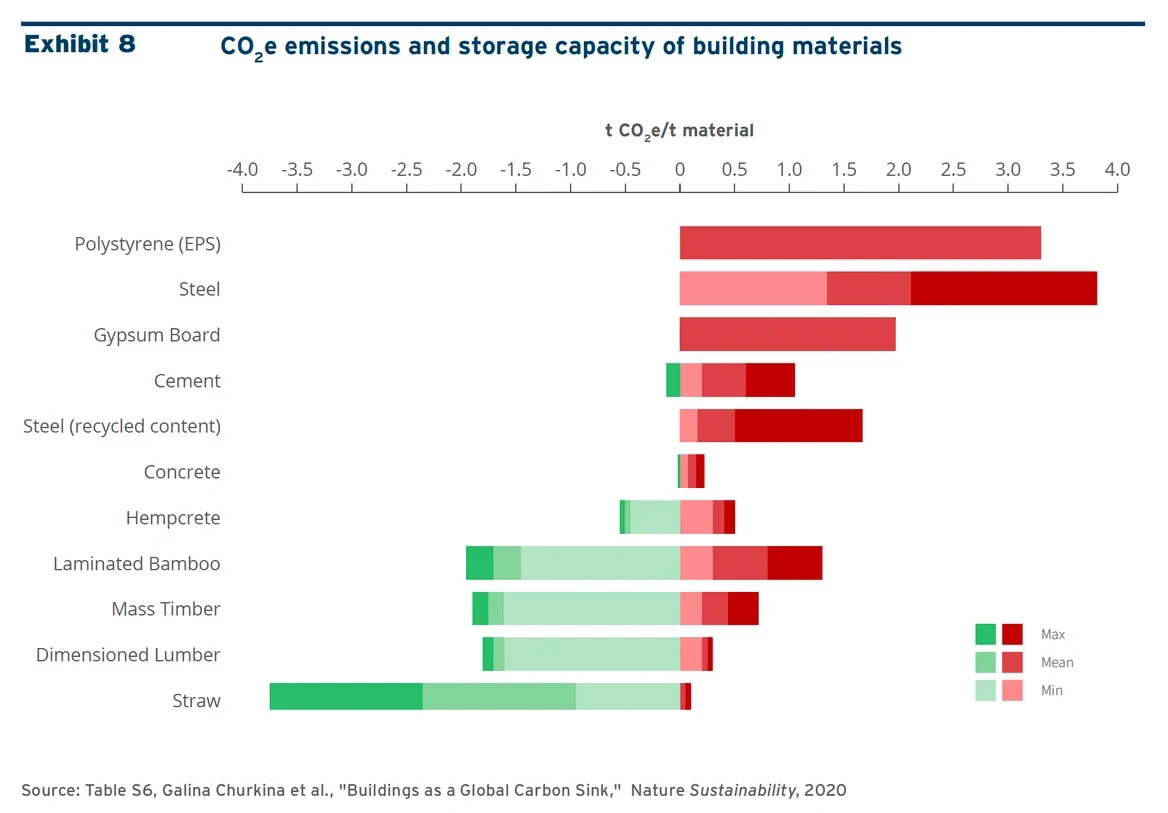Building materials could store more than 16 billion tonnes of CO2 annually, study

A new study published in Science magazine looked into the role of carbon-storing building materials in the efforts to mitigate climate change.
The research, conducted by academics from the Department of Civil and Environmental Engineering at the University of California and the Department of Earth System Science at Stanford University, showed that building materials have the potential to store more than 16 billion tonnes of carbon dioxide annually.
This substantial carbon storage capacity could be unlocked in a scenario where conventional building materials would be fully replaced with CO2-storing alternatives in new infrastructure.
As a result, approximately 16.6 ± 2.8 Gt of CO2 would be removed, an amount that equals roughly 50 percent of the carbon dioxide emitted from all anthropogenic sources in 2021.
The carbon-storing materials considered in this work include wood, bio-based plastic, carbonateable cement, carbonate-based aggregate, biochar cement filler, portlandite brick, biomass fiber-based brick, and bio-based asphalt bitumen.
According to the study, the total storage potential in building materials is heavily influenced by the scale of material use rather than the carbon storage capacity per unit mass.
While the authors note the work of various companies like Carbon Upcycling, BluePlanet, and O.C.O. Technology, which are currently offering carbon-storing building materials on the market, they also stress the need for larger-scale production to be able to reach the maximum storage capacity.
Besides being produced in larger volumes, these innovative materials would also need to establish themselves as a viable option for stakeholders in the construction industry if they are to become a dominant element in the building sector.
In that regard, in order for these sustainable building alternatives to be able to compete with conventional options, they would need to be cost-effective and to deliver the same level of material performance and safety.
Policy is another factor that could enable the accelerated adoption of these materials, where the governments and regulatory bodies could encourage the use of carbon-storing construction materials through incentives, building codes, and standards.
The global construction materials market size was valued at USD 1,320.01 billion in 2023 and is projected to grow from USD 1,369.86 billion in 2024 to USD 1,867.16 billion by 2032, exhibiting a CAGR of 3.9 percent during the forecast period.
Asia Pacific dominated the construction materials market with a market share of 48.44 percent in 2023. Moreover, the construction materials market size in the U.S. is projected to grow significantly, reaching an estimated value of USD 211.40 billion by 2032, driven by an ongoing infrastructure projects and technological advancements in building materials.
The growth of the market is tied to the construction industry's overall development. Increasing infrastructure spending and rising demand for residential apartments have surged the global construction industry in recent years, particularly in growing markets.
The demand driver for the market is increasing infrastructure investments, particularly in commercial projects.
Over the past few decades, there has been intense competition for clean highways and public infrastructure in developed markets. Furthermore, rising prosperity has increased property ownership, boosting the need for highway investment, which boosts the construction materials market growth.
Over time, government-sponsored projects are expected to boost construction material demand by stimulating business growth. Due to a rise in construction and urbanization, a few limitations can hinder the market growth.
These materials industry is currently faced with several environmental issues, such as increased dust, vibrations, noise, and soil water levels caused by exploration and processing.
Moreover, stiff competition puts pressure on industry vendors with high logistic costs while strict zoning laws and regulations on natural material extraction affect the movement of various product supplies.
The COVID-19 crisis widely affected construction activities all over the world. As the governments imposed lockdowns, all construction activities were halted, leading to a massive loss for the country and material manufacturers.
Most construction workers headed to their homes and engaged themselves in other work, unwilling to return and resume their work, which caused labor shortage in urban areas. The halt on work also directly impacted the company's revenues, jobs, and caused project delays.
Some of the world's largest employment providers include construction, infrastructure, and real estate sectors, which had been severely affected by the lockdown restrictions.
Smart building materials are adaptive and change their properties based on environmental conditions. Additive manufacturing technologies such as 3D printing help manufacturers create a market in a way that reduces waste. While 3D printing can't fully automate construction, workers are still needed to insert rebar into printed concrete structures.
Manufacturers in the construction materials industry are adapting modern technologies, which help them adapt to a shifting construction market.
Additive manufacturing methods and measurement instruments such as laser tools change the construction company's methodology.
Simultaneously, the developing fame of sustainable materials, similar to smart glass and composite shingles, makes it more comfortable for suppliers to offer feasible material choices to their clients.
Top Headlines
© 2025 IPPMEDIA.COM. ALL RIGHTS RESERVED

























